Translate this page into:
Innovative use of capsaicin patch 8% in treating thoracic facet syndrome
*Corresponding author: Hassan Abdulaziz Moria, Department of Surgery, University of Tabuk, Tabuk, Saudi Arabia. hmoria@ut.edu.sa
-
Received: ,
Accepted: ,
How to cite this article: Moria HA, Alatawi AM. Innovative use of capsaicin patch 8% in treating thoracic facet syndrome. J Neurosci Rural Pract. doi: 10.25259/JNRP_133_2025
Abstract
Thoracic facet joint pain is a commonly encountered but underresearched condition in spine and pain clinics. Management strategies are often limited, especially in refractory cases. Capsaicin 8% patch (Qutenza) is approved for certain neuropathic pain conditions, but its use in thoracic facet syndrome is novel and undocumented. We present two case reports of patients with chronic thoracic facet joint pain confirmed via diagnostic thoracic facet joint blocks and successful thoracic medial branch radiofrequency ablation. Both patients had persistent mid to lower thoracic mechanical pain despite multiple conservative and pharmacological treatments. Imaging ruled out significant disc pathology or central causes. Each patient underwent two cycles of capsaicin 8% patch application using standard protocols. The initial capsaicin patch application led to substantial pain relief in both patients, with effects lasting approximately 6 months. A second cycle resulted in over 80% pain reduction, with benefits sustained for up to 10 months. No significant adverse effects were reported. Both patients reported improvements in function and quality of life. Capsaicin 8% patches may offer an effective adjunctive therapy for patients with refractory thoracic facet joint pain. These case reports suggest sustained pain relief and functional improvement, warranting further studies to confirm efficacy, clarify mechanisms, and guide optimal use in clinical practice.
Keywords
Capsaicin patch 8%
Case report
Thoracic facet joint pain
Thoracic median branch radiofrequency
INTRODUCTION
Thoracic facet joint pain syndrome is a common but often underreported and undertreated condition that significantly impacts patients’ quality of life. This debilitating pain disorder is characterized by severe thoracic pain that worsens when sitting and sleeping, limiting functionality and causing considerable distress. Despite its prevalence, the condition remains a diagnostic challenge, with a lack of standardized management guidelines contributing to its suboptimal treatment.[1]
This report introduces a novel therapeutic approach using the capsaicin 8% patch (Qutenza) as a non-invasive alternative for managing thoracic facet joint pain. Capsaicin 8% patches have demonstrated efficacy in treating various chronic pain conditions by targeting cutaneous nociceptors and modulating pain transmission.[2] In the two cases presented here, patients with confirmed thoracic facet pain syndrome achieved sustained pain relief following treatment with this innovative modality.
By sharing these findings, this report aims to increase awareness of the capsaicin 8% patch as a potential treatment option for thoracic facet joint pain syndrome, offering a safer and less invasive alternative to traditional interventions. This contribution seeks to guide clinicians in managing similar cases and to encourage further exploration of this novel therapeutic avenue.
CASE REPORTS
Patient information
Case 1
A 39-year-old female presented with a 5-year history of chronic axial back pain localized in the mid- to lower thoracic region (T5–T11). Her pain, with an average intensity of 7/10, worsened after sitting for more than 30 min and during sleep. She denied anterior chest or abdominal pain, as well as lower or upper limb weakness or numbness. Initially managed by family physicians and spine surgeons, her condition proved refractory to various pharmacological and conservative treatments, including 18 sessions of physiotherapy, occupational therapy, and the use of nonsteroidal anti-inflammatory drugs (NSAIDs), muscle relaxants, and codeine, both orally and in patch form. Surgery was not recommended due to a lack of significant structural abnormalities.
At the pain clinic, her regimen was adjusted to include pregabalin, titrated up to 450 mg/day, combined with amitriptyline 50 mg/day. However, her pain relief was only partial and did not exceed 50%, limiting further dose escalation due to side effects.
Case 2
A 44-year-old male presented with a 7-year history of chronic axial thoracic pain from T6–T11. The pain was mechanical, worsening with sitting and during sleep, and rated 7/10 in severity. There was no radiating pain, numbness, or weakness. Despite undergoing extensive conservative measures, including 18 physiotherapy sessions, occupational therapy, and routine use of NSAIDs and muscle relaxants, his pain persisted. After spine surgeons ruled out surgical intervention, the patient was referred to the pain clinic and prescribed gabapentin 1200 mg/day and duloxetine 60 mg/day. Similar to Case 1, his pain showed partial improvement but did not exceed 50%, necessitating alternative approaches.
Clinical findings
Both patients exhibited dull, localized pain on thoracic spine extension and tenderness on palpation of bilateral paravertebral areas corresponding to their pain regions (T5–T11 in Case 1 and T6–T11 in Case 2). No patients exhibited radicular pain, numbness, or neurological deficits, with intact neurological examinations of the upper and lower limbs and normal gait. Imaging studies, including computed tomography (CT) and magnetic resonance imaging (MRI) of the thoracic spine, revealed degenerative osteophyte changes without intervertebral disc space loss or protrusions. Cervical spine and brain imaging were unremarkable.
Diagnostic assessment
Diagnostic evaluation included a thorough neurological examination, routine blood tests, and imaging studies. MRI, CT, and X-ray findings confirmed degenerative changes in the thoracic spine, consistent with mechanical thoracic facet joint pain syndrome, when ruling out alternative causes, such as nerve root compression or systemic conditions. The imaging studies provided crucial insights into the structural changes in the thoracic spine, aiding in the confirmation of the diagnosis [Figures 1-4].
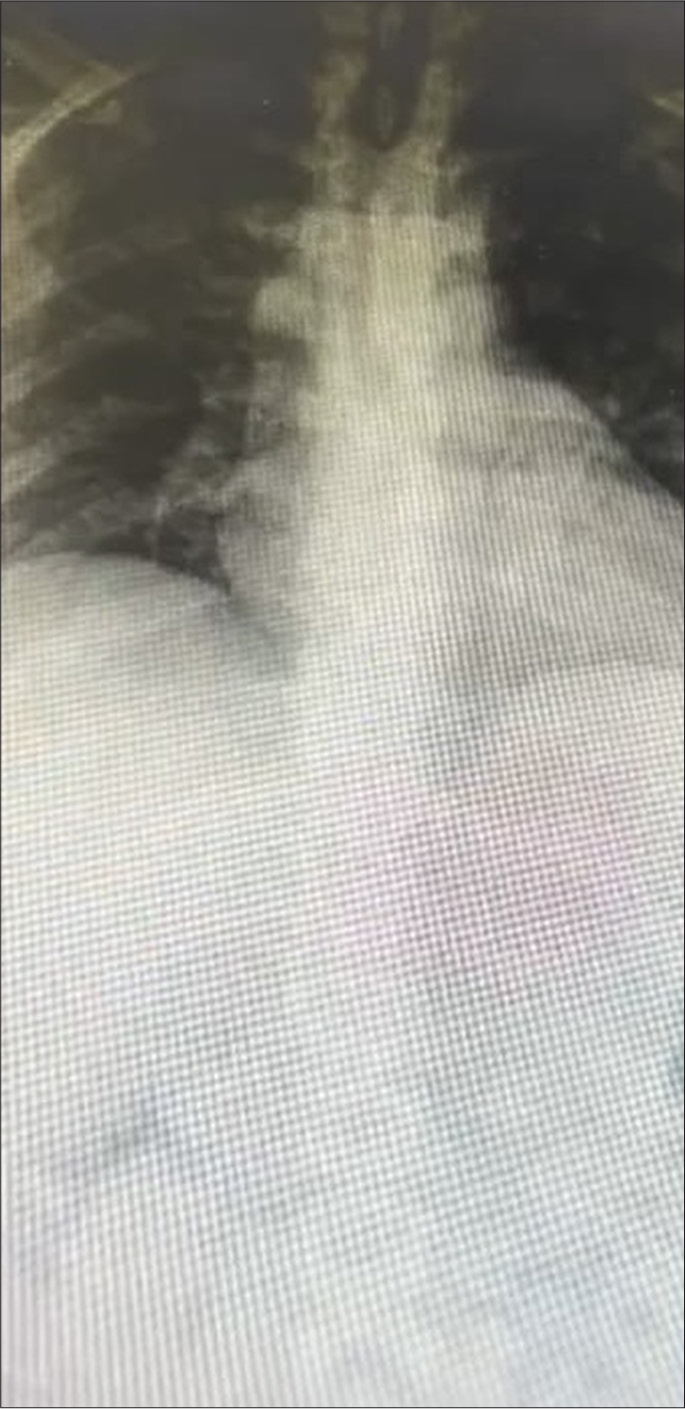
- Case 1 - Anteroposterior view of the thoracic spine, highlighting degenerative osteophyte changes.
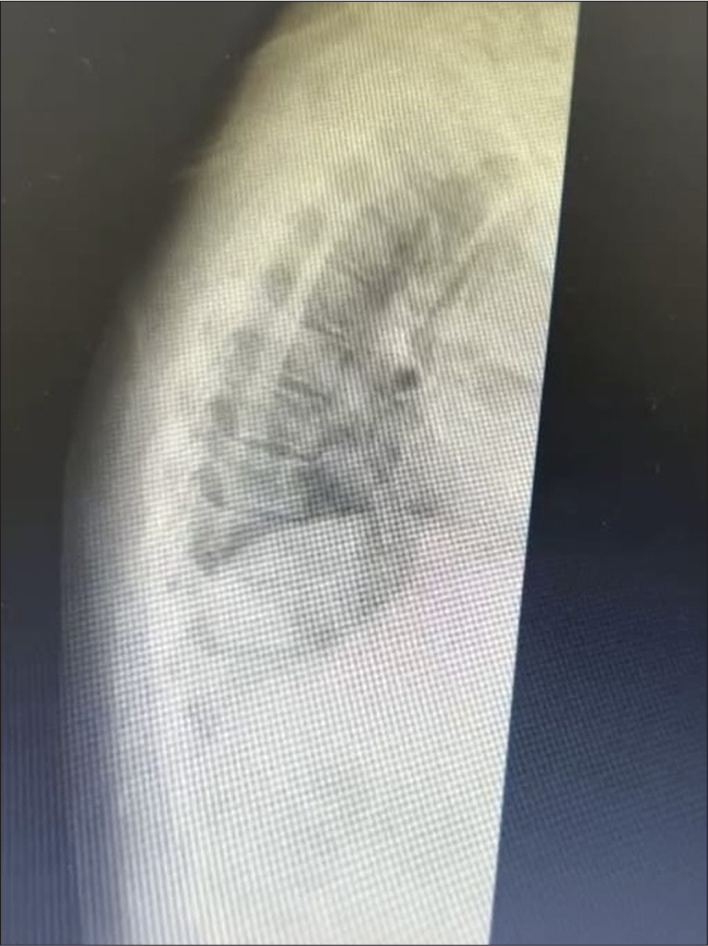
- Case 1 - Lateral view of the thoracic spine, illustrating facet joint involvement.
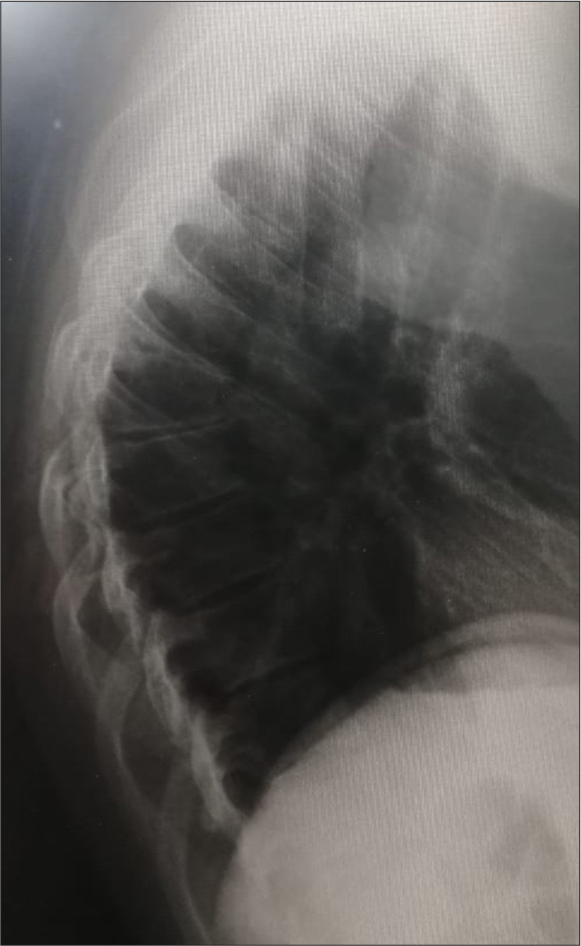
- Case 2 - Lateral view of the thoracic spine, demonstrating the degenerative osteophyte changes.
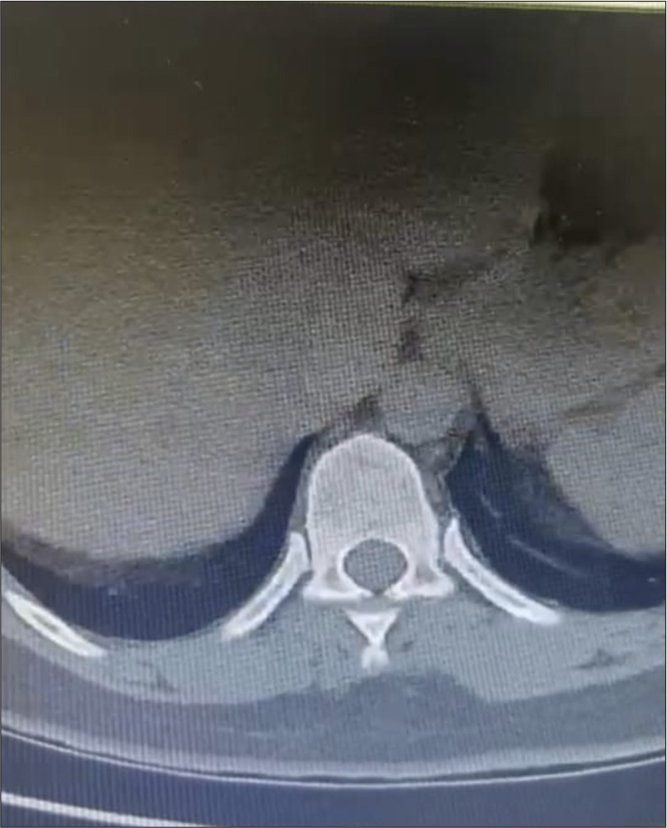
- Case 2 - CT thoracic spine, providing a detailed assessment of the bony structures.
Therapeutic intervention
Both patients underwent extensive initial management, including pharmacological and conservative treatments. While their medication regimens (pregabalin and amitriptyline in Case 1 and gabapentin and duloxetine in Case 2) provided partial relief, dose escalation was limited by side effects. In addition, both patients failed to achieve sustained pain relief with other modalities, including the following:
Trigger point injections (2% lidocaine, ultrasound-guided)
Botulinum toxin injections (200 units)
Platelet-rich plasma (PRP) injections, dry needling, and acupuncture.
Subsequently, each patient underwent fluoroscopic-guided thoracic facet joint blocks using 0.25% bupivacaine with 60 mg triamcinolone, resulting in significant (≥70%) pain reduction for 6 months and discontinuation of medications. The fluoroscopic-guided intervention targeted the affected facet joints, as visualized in Figures 1-4, ensuring precise delivery of the anesthetic and corticosteroid. However, the effects diminished after 6 months, prompting bilateral thoracic medial branch cooled radiofrequency ablation (RFA) in the operating theater. Both patients achieved ≥70% pain relief for 15 months without requiring medications.
After the RFA effects began to wear off, both patients consented to a trial of the capsaicin 8% patch (Qutenza) applied to the thoracic paraspinal region for 1 h. The application process is documented in Figure 5, illustrating the placement of the patch on the affected thoracic region. The first application resulted in ≥70% pain reduction sustained for 6 months. Upon recurrence of pain, a second cycle of the capsaicin 8% patch was applied, yielding >80% pain relief sustained for 9 months. Figure 6 captures the immediate post-application state, demonstrating the treatment approach and patient response [Table 1].
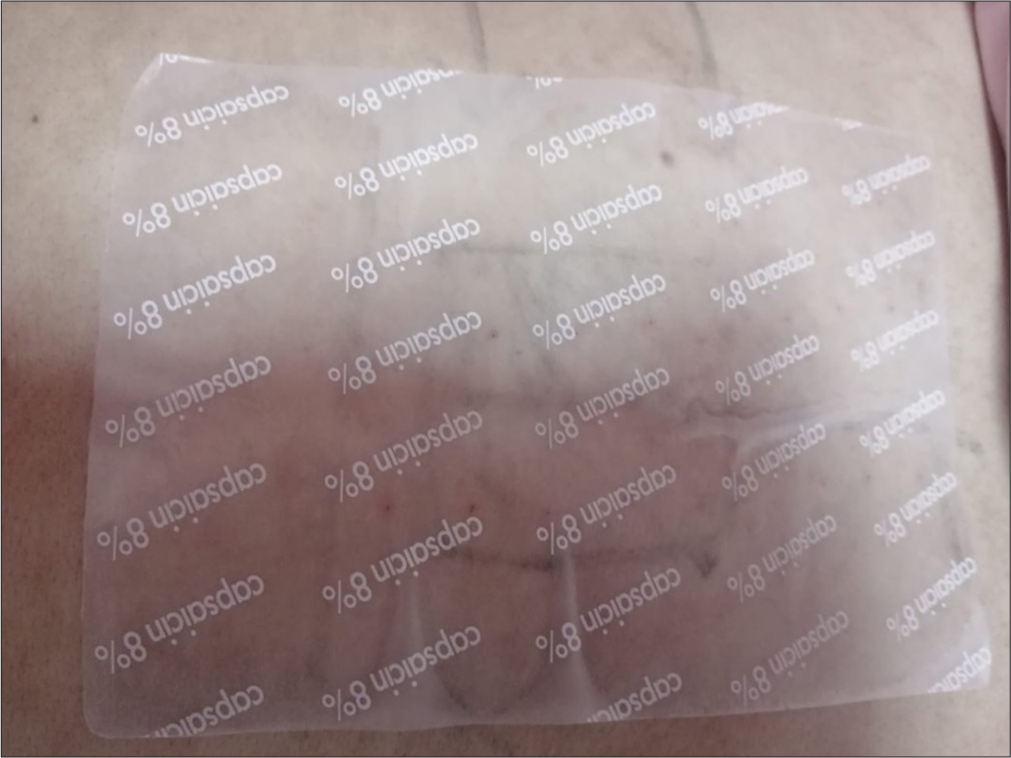
- Case 2 - Image taken during capsaicin 8% patch application, showing the targeted treatment area.
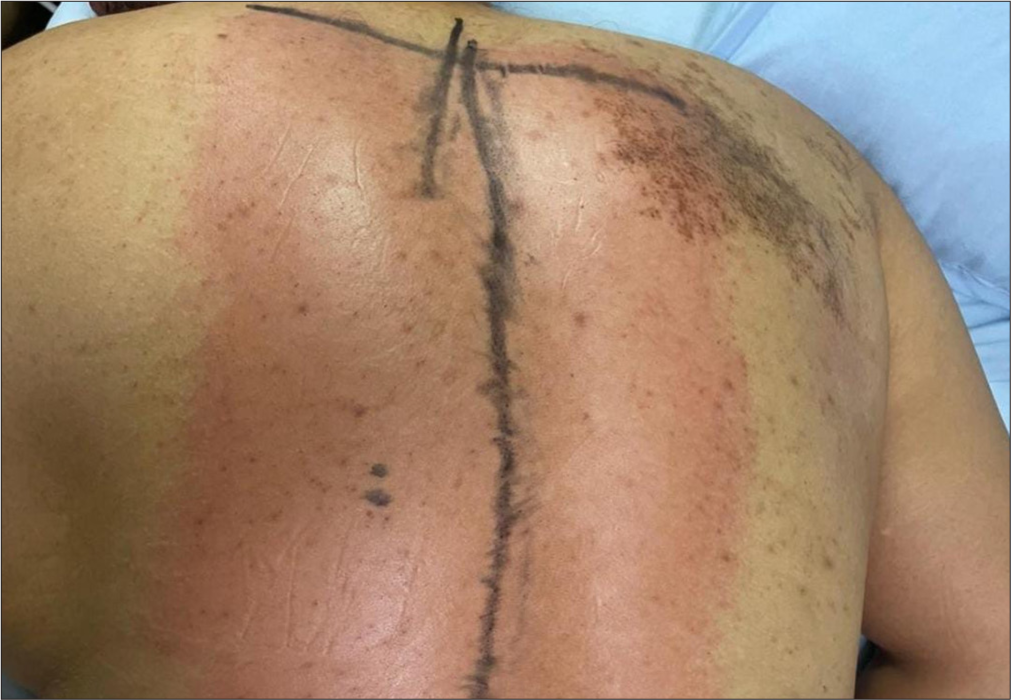
- Case 2 - Immediately post-application, illustrating the immediate response to the therapy.
| Stage | Case 1 | Case 2 |
|---|---|---|
| History and prior management | Chronic thoracic pain (5 years), unresponsive to NSAIDs, muscle relaxants, codeine, and physiotherapy. Surgery is not recommended. | Chronic thoracic pain (7 years), unresponsive to NSAIDs, muscle relaxants, and physiotherapy. Surgery is not recommended. |
| Initial presentation | Pain localized to T5–T11, worsened with prolonged sitting and sleep (7/10 intensity). | Pain localized to T6–T11, worsened with sitting and sleep (7/10 intensity). |
| Initial pharmacological therapy | Pregabalin (450 mg/day) + amitriptyline (50 mg/day); partial relief (<50%) due to side effects. | Gabapentin (1200 mg/day) + duloxetine (60 mg/day); partial relief (<50%) due to side effects. |
| First intervention | Fluoroscopic-guided facet joint block (bupivacaine+triamcinolone); ≥70% pain relief for 6 months. | Fluoroscopic-guided facet joint block (bupivacaine+triamcinolone); ≥70% pain relief for 6 months. |
| Second intervention | Bilateral thoracic medial branch cooled RFA; ≥70% relief for 15 months. | Bilateral thoracic medial branch cooled RFA; ≥70% relief for 15 months. |
| Capsaicin 8% patch treatment | Applied for 1 h: First cycle ≥70% relief for 6 months; second cycle >80% relief for 9 months. | Applied for 1 h: First cycle ≥70% relief for 6 months; second cycle >80% relief for 9 months. |
| Current status | Significant improvement in pain and function; no recurrence, no medications. | Significant improvement in pain and function; no recurrence, no medications. |
RFA: Radiofrequency ablation, NSAIDs: Nonsteroidal anti-inflammatory drugs.
Informed consent
Written informed consent was obtained from both patients for the publication of their clinical data and any accompanying images. Both patients were assured that their identities would remain confidential, and they expressed their agreement regarding the use of their anonymized information for academic and research purposes.
Follow-up and outcomes
Both patients tolerated capsaicin 8% patch applications without significant adverse effects. The first cycle provided 6 months of pain relief, while the second extended relief to 9 months. Patients neither required additional daily medications nor experienced further pain progression during these periods.
At follow-up, the patients reported substantial improvement in pain intensity and functional capacity, expressing high satisfaction with the treatment. Long-term monitoring continued, with no reported musculoskeletal complications or significant pain recurrence to date.
This case series highlights the efficacy of capsaicin 8% patches as a novel, non-invasive therapeutic option for thoracic facet joint pain, particularly in patients refractory to conventional treatments. These findings warrant further investigation to explore their mechanisms, safety, and long-term outcomes.
DISCUSSION
RFA is increasingly recognized as an effective intervention for managing thoracic facet joint pain, a condition that can significantly impact quality of life. A systematic review and meta-analysis indicated that RFA offers Level III evidence of long-term pain management in thoracic facet joint pain, with success defined as pain reduction lasting more than 6 months.[3] In addition, an observational study found that RFA improved health-related quality of life (HRQoL) in 65% or more patients, with benefits lasting 12 months or more in nearly half of the cases.[4]
Performing RFA in the thoracic region requires a thorough understanding of the anatomy and a precise technique. The procedure involves targeting the medial branches of the nerves, which can vary anatomically from T1 to T12.[5] Prior to RFA, diagnostic medial branch blocks or facet joint blocks are used to confirm the source of pain. These blocks are the only reliable diagnostic tool for thoracic facet joint pain.[6] Successful blocks can predict the effectiveness of subsequent RFA.[3]
While RFA is generally safe, complications can occur, primarily due to improper needle placement or injection. Common issues include trauma to surrounding tissues and hematoma formation.[7] Despite promising results, the literature on RFA for thoracic spine pain is limited, with most studies being observational. There is a need for larger randomized controlled trials to better establish the long-term efficacy and safety of this intervention.[8]
Studies have consistently shown that the capsaicin 8% patch significantly reduces pain intensity in patients with painful diabetic neuropathy. In a retrospective analysis, most patients experienced a 50% or greater reduction in pain after treatment, with some showing progressive pain reduction over multiple applications.[9] The patch not only reduces pain but also positively impacts HRQoL. Patients reported improvements in pain management and daily functioning after treatment with the capsaicin patch.[10]
Thoracic facet joint pain is a significant contributor to chronic thoracic pain, with prevalence rates between 34% and 48% in patients with chronic thoracic pain.[1] While direct evidence is lacking, the mechanism of action of capsaicin in desensitizing pain receptors could theoretically benefit patients with thoracic facet joint pain, particularly those with neuropathic components. Given the temporary relief observed in other neuropathic conditions, capsaicin patches may serve as an adjunctive treatment for thoracic facet joint pain, especially in patients who do not respond to conventional therapies.
In contrast, the management of thoracic facet joint pain typically involves more established intervention techniques, such as medial branch blocks and radiofrequency neurotomy, which have been studied more extensively. The use of capsaicin patches, while promising, requires further investigation to establish their efficacy and safety in this specific context. The potential for capsaicin to provide temporary relief could complement existing treatments, offering a broader range of options for patients with chronic thoracic facet joint pain.
Patient perspective
Case 1
The 39-year-old female patient expressed significant relief and satisfaction following treatment with the capsaicin 8% patch. She highlighted the profound improvement in her quality of life after years of debilitating pain that disrupted her daily activities, including sleeping and sitting for prolonged periods. She appreciated the non-invasive nature of the patch compared to earlier interventional procedures, such as facet blocks and radiofrequency ablation, and was particularly relieved to avoid the daily use of medications that had previously caused side effects. The patient described sustained pain relief as life-changing, enabling her to resume activities she had previously avoided.
Case 2
The 44-year-old male patient echoed similar sentiments, noting a remarkable reduction in pain intensity and improvement in his ability to perform daily activities without discomfort. He expressed gratitude for finally finding effective treatment after years of unsuccessful attempts with various pharmacological and conservative therapies. The simplicity of the capsaicin patch application and the long-lasting relief it provided were particularly appealing to him, as he had grown weary of repeated interventional procedures. The patient emphasized that this therapy restored his sense of normalcy and allowed him to engage more fully in his personal and professional life.
Both patients reported no significant side effects from the capsaicin patch and were optimistic about its continued use in managing their thoracic facet joint pain. Their shared experiences underscore the importance of exploring novel patient-centered treatment modalities for chronic pain management.
CONCLUSION
Thoracic facet joint pain is a challenging clinical entity that is often underrecognized and inadequately treated. While traditional interventions, such as thoracic facet joint blocks and radiofrequency ablation, have demonstrated efficacy, their benefits are often temporary and may carry procedural risks. This report highlights the potential of using 8% capsaicin patches as a novel, non-invasive therapeutic option for managing chronic thoracic facet pain.
Both cases demonstrated significant and sustained pain relief following the application of the capsaicin patch, with reductions in pain intensity exceeding 70% and durations of relief extending up to 9 months after subsequent applications. Importantly, the treatment was well tolerated, with no significant side effects reported, enabling discontinuance of systemic medications and enhancing the patients’ quality of life.
These findings underscore the capsaicin patch’s potential to serve as an effective and safe alternative for patients with thoracic facet pain syndrome, particularly those who have exhausted conventional therapeutic options. Further research, including randomized controlled trials, is warranted to validate its long-term efficacy and safety in broader patient populations.
Considerations and future research
The use of an 8% capsaicin patch for the management of thoracic facet joint pain represents a promising, minimally invasive therapeutic option. However, there are several considerations that clinicians must take into account when integrating this treatment into clinical practice. First, the mechanism of action of high-dose capsaicin, which involves desensitizing nociceptive fibers, warrants further exploration to optimize its application in different pain syndromes. Second, patient selection criteria must be refined to identify individuals most likely to benefit from this approach, particularly those with refractory pain that has been unresponsive to conventional treatments.
While the cases presented demonstrated significant and sustained pain relief, the duration of efficacy and potential for cumulative effects with repeated applications require further investigation. Variability in response between patients and factors influencing the duration of analgesic effects should also be studied.
Although the current report presents outcomes up to 12 weeks post-treatment, both patients are being monitored for long-term follow-up to assess the durability of pain relief and functional improvement. These extended outcomes will be reported in a future follow-up study, which may provide further insights into the long-term efficacy and safety of high-concentration capsaicin patches in managing thoracic facet syndrome.
Future research should focus on the following:
Conducting randomized controlled trials to compare the efficacy and safety of capsaicin patches with standard interventional techniques, such as radiofrequency ablation
Evaluating the long-term outcomes and potential adverse effects of repeated capsaicin patch applications
Investigating the role of high-dose capsaicin in combination with other modalities, such as pharmacological agents or physical therapies, to enhance treatment outcomes
Exploring patient-reported outcomes, including quality of life measures, functional improvements, and satisfaction with treatment.
By addressing these gaps, clinicians can better understand the therapeutic potential of capsaicin patches and incorporate them as a viable alternative in the multidisciplinary management of thoracic facet joint pain.
Ethical approval:
Institutional Review Board approval is not required.
Declaration of patient consent:
The authors certify that they have obtained all appropriate patient consent.
Conflicts of interest:
There are no conflicts of interest.
Use of artificial intelligence (AI)-assisted technology for manuscript preparation:
The authors confirm that there was no use of artificial intelligence (AI)-assisted technology for assisting in the writing or editing of the manuscript, and no images were manipulated using AI.
Financial support and sponsorship: Nil.
References
- Capsaicin: Mechanisms and therapeutic potential in pain management. J Pain Res. 2019;12:1-11.
- [Google Scholar]
- Systematic review and meta-analysis of the long-term efficacy of radiofrequency ablation in thoracic facet joint pain. J Pain Res. 2023;16:789-99.
- [Google Scholar]
- Health-related quality of life following RFA for thoracic pain: A prospective observational study. Scand J Pain. 2018;17:245-53.
- [Google Scholar]
- Technical considerations in RFA for thoracic facet joint pain. Pain Med. 2019;20:2341-9.
- [Google Scholar]
- Diagnostic accuracy of medial branch blocks in thoracic spine pain. Clin Spine Surg. 2024;37:e302-8.
- [Google Scholar]
- Complications of thoracic facet blocks and ablations In: Erdine S, Staats PS, eds. Complications of pain-relieving procedures. Hoboken: John Wiley and Sons; 2022. p. :199-205.
- [CrossRef] [PubMed] [Google Scholar]
- Randomized controlled trials for thoracic facet joint pain: A call for further research. Pain Manage. 2023;13:603-12.
- [Google Scholar]
- Ongoing treatments with high concentration capsaicin topical system results in progressive pain reduction for painful diabetic neuropathy-a retrospective real-world analysis. Diabetes. 2024;73:490.
- [CrossRef] [Google Scholar]
- Topical capsaicin 8% patch in peripheral neuropathic pain: Efficacy and quality of life. Br J Pain. 2024;18:42-56.
- [CrossRef] [PubMed] [Google Scholar]






